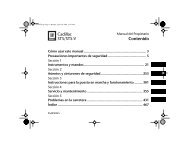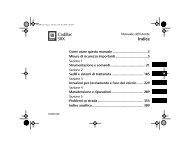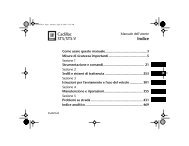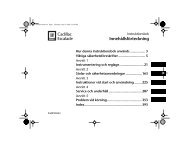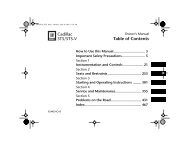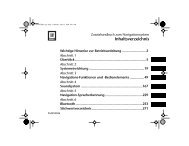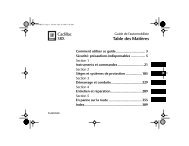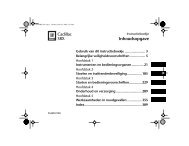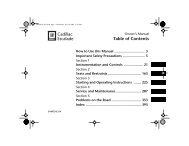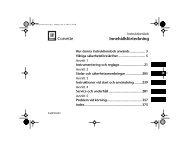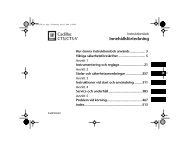Owner's Manual Cadillac BLS - IFS Europe BV
Owner's Manual Cadillac BLS - IFS Europe BV
Owner's Manual Cadillac BLS - IFS Europe BV
Create successful ePaper yourself
Turn your PDF publications into a flip-book with our unique Google optimized e-Paper software.
460_OM_MY09.book Page 158 Wednesday, April 2, 2008 10:32 AM<br />
158 Starting and driving<br />
Economical motoring<br />
Factors affecting fuel<br />
consumption<br />
The fuel consumption of a car is greatly<br />
affected by driving conditions, climate, road<br />
conditions, speed, driving technique, and so<br />
on.<br />
Running-in<br />
Fuel consumption may be somewhat higher<br />
during the running-in period (the first<br />
3100-4350 miles/5000-7000 km) than<br />
stated values.<br />
Weather conditions<br />
Summer temperatures give better fuel<br />
economy that winter ones. The difference<br />
can be as much as about 10 per cent. Consumption<br />
increases in cold weather<br />
because the engine takes longer to reach its<br />
normal operating temperature. The transmission<br />
and wheel bearings also take<br />
longer to warm up. Even distance affects<br />
consumption: short journeys of three to<br />
five 3 to 5 miles (5-8 km) do not give the<br />
engine enough time to reach its optimum<br />
temperature. Wind conditions also have a<br />
marked effect on consumption.<br />
How to read the diagram (the following<br />
example relates to petrol-engined cars):<br />
If fuel consumption with the engine at normal<br />
temperature is 28 mpg (10 l/100 km), the<br />
actual fuel consumption 3 miles (5 km) after<br />
the engine has started from cold will be:<br />
– 23.5 mpg (12 l/100 km) at outside temp.<br />
of +20 °C (increase of 20 %).<br />
– 17.7 mpg (16 l/100 km) at outside temp.<br />
of 0 °C (increase of 60 %).<br />
– 14.1 mpg (20 l/100 km) at outside temp.<br />
of –20 °C (increase of 100 %).<br />
It is clear from the diagram that both distance<br />
driven and outside temperature have<br />
a significant impact on fuel consumption,<br />
after a cold start.<br />
If the car is normally driven on short journeys<br />
of 3 to 5 miles (5–8 km), for example<br />
to and from work, the average consumption<br />
will be 60-80 per cent above the normal<br />
level.<br />
Percentage increase in fuel consumption<br />
of engine starting from cold compared to<br />
engine at normal temperature<br />
Driving techniques<br />
• To achieve the best running economy,<br />
with regard to fuel consumption and general<br />
wear, the car must be serviced regularly.<br />
• High speed, unnecessary acceleration,<br />
frequent braking and much changing<br />
down all give higher fuel consumption.<br />
• Frequent gear changing in traffic, starting<br />
in cold weather, the use of studded tyres<br />
and roof racks, and towing a caravan all<br />
increase fuel consumption.




